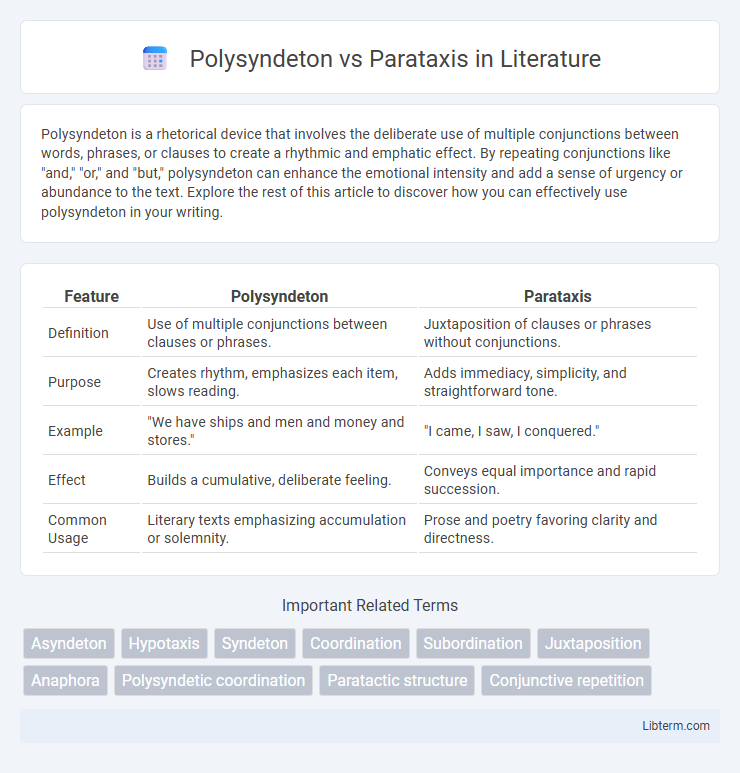Polysyndeton is a rhetorical device that involves the deliberate use of multiple conjunctions between words, phrases, or clauses to create a rhythmic and emphatic effect. By repeating conjunctions like "and," "or," and "but," polysyndeton can enhance the emotional intensity and add a sense of urgency or abundance to the text. Explore the rest of this article to discover how you can effectively use polysyndeton in your writing.
Table of Comparison
| Feature | Polysyndeton | Parataxis |
|---|---|---|
| Definition | Use of multiple conjunctions between clauses or phrases. | Juxtaposition of clauses or phrases without conjunctions. |
| Purpose | Creates rhythm, emphasizes each item, slows reading. | Adds immediacy, simplicity, and straightforward tone. |
| Example | "We have ships and men and money and stores." | "I came, I saw, I conquered." |
| Effect | Builds a cumulative, deliberate feeling. | Conveys equal importance and rapid succession. |
| Common Usage | Literary texts emphasizing accumulation or solemnity. | Prose and poetry favoring clarity and directness. |
Introduction to Polysyndeton and Parataxis
Polysyndeton is a rhetorical device characterized by the deliberate use of multiple conjunctions in close succession, enhancing the rhythm and emphasis of a sentence. Parataxis involves placing clauses or phrases side by side without coordinating or subordinating conjunctions, creating a concise and straightforward expression. Both techniques impact sentence structure and tone, influencing how ideas are presented and perceived in writing.
Defining Polysyndeton: Meaning and Examples
Polysyndeton is a rhetorical device characterized by the deliberate use of multiple conjunctions between clauses or items in a sentence, such as "and," "or," or "but," to create emphasis and rhythm. Unlike parataxis, which places clauses or phrases side by side without conjunctions or with minimal use, polysyndeton slows the pace and enhances the emotional intensity of the text. Classic examples include biblical passages like "and every living creature that moveth" (King James Bible) and literary works such as Hemingway's "He ran and jumped and laughed for joy."
What is Parataxis? Key Features and Uses
Parataxis is a rhetorical device characterized by the placement of clauses or phrases one after another without using conjunctions to link them explicitly, creating a simple, direct style of expression. Key features include the use of short, independent clauses juxtaposed with minimal or no conjunctions, which often produces a rhythmic or fragmented effect that emphasizes each statement equally. Commonly employed in literature and speeches, parataxis fosters immediacy and clarity, allowing readers or listeners to interpret meaning through the straightforward presentation of ideas.
Historical Origins of Polysyndeton and Parataxis
Polysyndeton traces its historical origins to ancient Greek and Latin literature, where multiple conjunctions were deliberately used to create a rhythmic and emphatic effect, particularly in epic poetry like Homer's Iliad. Parataxis, characterized by the juxtaposition of clauses without conjunctions, also originates from classical antiquity, prominently employed by authors such as Julius Caesar to produce concise and straightforward prose. Both rhetorical devices reveal early literary techniques aimed at manipulating sentence structure for emphasis and clarity in classical texts.
Polysyndeton vs Parataxis: Structural Differences
Polysyndeton employs multiple conjunctions between clauses, creating a rhythm that emphasizes each element and slows the pace, while parataxis places clauses or phrases side by side without conjunctions, producing a concise and direct effect. In polysyndeton, repeated use of conjunctions like "and" or "or" links each component, enhancing coordination and cumulative impact. Parataxis relies on simple, straightforward juxtaposition, often using commas or semicolons to convey parallel ideas or actions without explicit connectors.
Effects on Rhythm and Tone
Polysyndeton employs multiple conjunctions in close succession, creating a deliberate, measured rhythm that often slows the pace and emphasizes each element, thereby intensifying the tone with a sense of gravity or overwhelm. Parataxis uses short, simple sentences or phrases placed side by side without conjunctions, generating a rapid, staccato rhythm that can produce a brisk, direct, or terse tone. The choice between polysyndeton and parataxis significantly affects the pacing and emotional impact of a text by manipulating how rhythm shapes the reader's perception.
Literary Examples of Polysyndeton
Polysyndeton is a literary device characterized by the deliberate use of multiple conjunctions in close succession, enhancing rhythm and emphasizing each element in a series; a classic example appears in the Bible, Genesis 1: "And God said, 'Let there be light,' and there was light, and God saw the light, and it was good." In William Faulkner's "The Sound and the Fury," polysyndeton intensifies emotional turmoil: "He was a God's little acre, hematite and mica and zircons and quarts." This technique contrasts with parataxis, which involves placing clauses or phrases side by side without conjunctions, creating a different pacing and syntactical effect.
Literary Examples of Parataxis
Parataxis features the placement of short, simple clauses or phrases one after another without coordinating or subordinating conjunctions, exemplified in Hemingway's "He was a bold man. He was a wise man. He was a sad man." This technique fosters a rapid, straightforward rhythm, mirroring natural speech and enhancing emotional impact. Literary examples include William Carlos Williams' "The Red Wheelbarrow," where paratactic structure emphasizes clarity and immediacy by juxtaposing vivid images.
When to Use Polysyndeton or Parataxis in Writing
Polysyndeton is effective for emphasizing each element in a list, creating a deliberate, rhythmic pace that can heighten emotional intensity or build suspense. Parataxis offers clarity and immediacy by presenting ideas in straightforward, succinct phrases without conjunctions, ideal for dynamic or journalistic writing. Writers should choose polysyndeton when seeking to slow down the narrative and highlight connections, while parataxis works best for rapid progression and simplicity.
Conclusion: Enhancing Style with Polysyndeton and Parataxis
Polysyndeton, characterized by the deliberate use of multiple conjunctions, intensifies rhythm and emphasizes each element in a series, creating a heightened emotional effect. Parataxis, employing simple, short clauses without conjunctions, produces a straightforward and impactful style that conveys immediacy and clarity. Mastering both techniques enables writers to vary sentence structure effectively, enriching narrative flow and enhancing stylistic expression.
Polysyndeton Infographic

 libterm.com
libterm.com